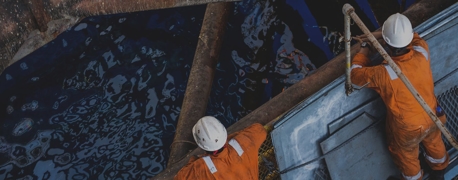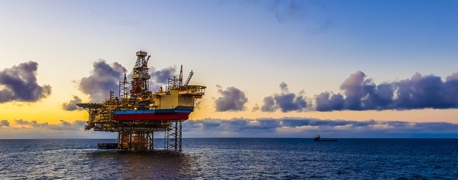Dry Docking: Safety, Repairs & Maintenance for Ships

While ships are initially built on dry docks, dry docking mainly refers to the recurring process of vessels being inspected and repaired out of the water so crews can reach parts of the ship that are normally submerged. This process usually takes place on a floating dry dock or a graving dock.
A floating dry dock is not attached to land and can travel toward ships. This platform is sometimes U-shaped with a concave upper section for the boat to settle in and will have walls along the wings. The vessel pulls up onto the floating dry dock, and then water is pumped out of this floating dock to lift it, and the vessel, above the water. In this way, the entirety of the ship’s hull will be above the water line and can be inspected and worked on.
A graving dock can be found along a harbor, attached to land. This is a basin that has been dug out of the ground and reinforced with steel and/or concrete, with high walls for the rear, left, and right. The caisson—or lock gate—sits between this dock and the water. When the gate is lifted, a ship can pull in and onto blocks. Then the caisson will shut again so the water can be pumped out, letting the ship rest on the blocks. This type of dry dock is needed for large vessels, such as tankers, cruise ships, and aircraft carriers.
For smaller vessels, such as tugboats, sailboats, patrol vessels, and catamarans, for example, there is also the option of mobile lifts to move the boats above the water line and get work done, using winches onshore or an electric system to hoist the ship.
What is dry docking supposed to accomplish? The dry docking process can include:
- Inspections of the ship’s entire exterior
- High-pressure washing to get rid of algae, barnacles, chlorides, and more from below the water line
- Sandblasting to clear away rust, old paint, etc. from the hull
- Assessing the thickness of the hull (an ultrasonic gauge can ensure that a hull isn’t compromised)
- Repairs for propellers, rudders, etc.
- Maintenance or replacements for anchor and chain, the engine room, ballast water tank, and more
- Applying new coats of anti-fouling paint (to prevent marine growth like barnacles)
When Is Dry Docking Needed?
For many ships, U.S. Navy vessels included, dry docking is required by the International Convention for the Safety of Life at Sea (SOLAS). This treaty’s first iteration came about in 1914 after the sinking of the Titanic, and it’s meant to ensure safe maritime transportation. The most recent changes were made to SOLAS in 1980, and this treaty includes mandates for lifeboats, radiocommunications, fire detection and extinction, and more. One of its provisions requires ships to service their ships in a dry dock twice every five years, with a survey conducted somewhere around the halfway point. This applies to both merchant vessels (like cargo ships) and passenger vessels (like cruise ships).
For cruise ships, the bottom of a ship must be inspected every year. Within a five-year period, two of these inspections must be done at a dry dock—and you can’t go more than three years between dry dock inspections. For years when the inspection isn’t conducted at a dry dock, underwater welders and other specialists can conduct the necessary inspections and repairs.
Outside of normally scheduled dry dockings, a dry dock project may be necessary if a vessel has grounded or collided with anything, such that underwater parts of the ship are likely damaged.
How Long Does a Ship Stay in Dry Dock?
On average, a ship can spend 10 days in a dry dock, but depending on how damaged a ship is and how much work needs to be done, dry docking can take weeks or even months. Some vessels end up being worked on in a dry dock for a year or more.
Simply draining the water from the dock can take a full night—8 to 10 hours—before the inspection and work can begin. This doesn’t take into account the months of planning that often lead up to dry docking, everything from securing the dry dock and onshore crews needed to carry out the dry docking to detailing what kind of work needs to be done on the ship.
However long a boat or ship sits in a dry dock is however long that ship is losing money from not being in service and requiring costly repairs and maintenance.
What Workers Are Involved in Dry Docking?
A technical team on land handles many aspects of dry docking, but a ship’s crew is still involved in many of the details as well. There are often contractors, subcontractors, consultants, and other specialists involved in everything from inspections and welding to rewiring, painting, and more.
Overseeing the whole affair is the dockmaster, or the drydock master, who is also called a shipyard master and/or port master depending on where you go. The dockmaster coordinates with ships months in advance, ensuring that the teams and materials needed for each ship are at the dock when the vessel arrives. Dockmasters have to strategize how to get ships safely docked without capsizing, factoring in their structure and dimensions, and how to handle maintenance.
The dockmaster has to oversee the ship repairs, coordinating with tugboats, consultants, insurance, crews, and so forth, making sure that the work is regulation compliant, the project stays on schedule and within budget, and that the workers are safe. From servicing small fishing boats to cruise liners, cargo ships, and military vessels, dockmasters have to pull off complex operations time and again.
Some of the other personnel involved in dry docking include:
- Surveyors
- Engineers
- Welders
- Electricians
- Painters
- Other contractors and subcontractors
Of course, no matter how well a dockmaster puts together a plan, an inspection could reveal surprise repairs that are needed, and bad weather can suddenly force delays.
What Does a Ship’s Crew Do During Dry Docking?
In some cases, especially for certain workers on cruise ships, dry docking might be a period of unpaid leave, but everyone else on a ship who is still collecting pay will be working and living aboard the vessel. It may be possible to get some time to go onshore, but there would still be a curfew and other restrictions.
For the dry docking process itself, the ship’s crew can be responsible for:
- Reducing ballast and trim to get the ship ready for dry docking
- Maintaining ballast and monitoring the vessel’s stability throughout the dry dock process
- Securing loose items
- Disconnecting power
- Removing drain plugs to let water and other liquids out
After helping the team on the dock get the ship safely in position, the ship’s crew could also help with inspections and repairs. If your normal role on a ship doesn’t translate well to some of the onboard or exterior projects being done, you could get assigned to fire watch, which would mean standing by as welders and other contractors are at work, ready with a fire extinguisher to keep any flames from breaking out.
To take advantage of the time in a dry dock, crew members also work on projects such as:
- Deep cleaning
- Replacing flooring, bedding, etc.
- Equipment repair
- Rewiring and software updates
- Purchasing supplies and equipment
Do Companies Delay the Process of Dry Docking?
It’s not in companies’ interests to avoid dry docking altogether, not if they want an efficient, seaworthy vessel, but some are highly motivated to have the ship sit in a dry dock for as short a time as possible. There is a lot of pressure on workers to speed things along quickly to get the vessel back into service.
There are also legal ways to delay going to a dry dock. With Extended Dry Docking (EDD) provisions, certain vessels can get an extension of the dry docking period from twice every 5 years to twice every 7.5 years. This allows qualifying ships to instead get In-Water Surveys (IWS) done during this period by an approved diving company, allowing for more time between mandated dry docking projects. Only ships that have good IWS results get to keep this classification, and this EDD tends to only be available for container ships and certain cargo ships that are younger than 15 years old.
What Are the Dangers of Dry Docking?
Dry docking combines some of the dangers of maritime work with the well-documented hazards of construction sites. The risks and dangers are manifold, from repair crews and painters working on scaffolds and getting exposed to toxic chemicals and gases, to electricians and welders working in environments with flammable materials and fluids.
Some of the risks in dry docking include and certainly aren’t limited to:
- Capsizing
- Crane accidents
- Scaffolding accidents
- Falls from height
- Falling objects
- Struck-by and caught-in accidents
- Fires
- Explosions
- Electrical shocks and electrocution
This is true from the start through to the end of the dry docking process. Capsizing is most often a risk when the water is being pumped out of a dry dock and the ship is being lowered onto blocks. These highly preventable disasters can result in serious, even fatal injuries to dock and ship workers. Even dislodging or tipping of the boat can be disastrous, such as in March of 2023, when a U.S. Navy ship tipped over at a 45-degree angle during dry docking in Edinburgh. This accident sent 23 people to the hospital with injuries that included cracked ribs, a dislocated elbow, and a fractured pelvis, while 12 other workers were injured and required first aid at the scene.
Even once the repairs are done and the dock is filling with water again to get the ship back to sea, there are still dangers involved. For instance, there have been leaks that were overlooked during some dry dockings, some serious enough that engine rooms have flooded during this refloating procedure, resulting in workers drowning.
Injured Workers’ Options After Dry Docking Accidents
Dry docking is a necessary but complicated and dangerous endeavor. Despite all the coordination and planning ahead involved, any error in dry docking can lead to catastrophic, life-changing injuries and deadly accidents. When it comes to covering the income losses, medical bills, and other damages that result from dry docking accidents, dock workers could be owed compensation under the Longshore and Harbor Workers’ Compensation Act (LHWCA), and ship crew members could pursue Jones Act claims, for example. Whether it’s a shipowner, dockmaster, or some other party at fault for an accident during dry docking, injured workers must recognize that they have legal options for getting the financial compensation they need and deserve.
- Categories


